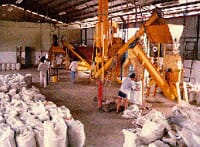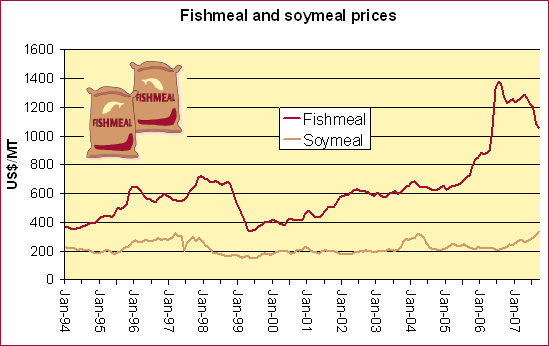Further decline in production
 |
The five main exporting countries reported 1.8 million tonnes output in the first seven months of the year, which is a 3% decline over the corresponding period of 2007. This decline was caused by sharp drops in production in the Scandinavian countries and Chile, while Peru reported for the first time, higher production. Despite lower production, prices of fishmeal declined in the course of 2007. This was caused by high stock of fishmeal in China, the main market, while Peruvian producers were trying to sell at discounted prices. However, prices are likely to have bottomed out at their present level of US$ 1 050./tonne.
| Production Fishmeal: World | ||||||||
| 2001 | 2002 | 2003 | 2004 | 2005 | 2006 | Jan-Jul 2006 |
Jan-Jul 2007 |
|
|---|---|---|---|---|---|---|---|---|
|
(1000 tonnes) |
||||||||
| Chile | 698 | 834 | 667 | 935 | 815 | 776 | 585.2 | 538.6 |
| Peru | 1844 | 1929 | 1219 | 1983 | 2126 | 1456 | 894.5 | 930.5 |
| Norway | 216 | 227 | 196 | 212 | 154 | 176 | 188.1 | 116.1 |
| Denmark | 299 | 311 | 246 | 259 | 222 | 213 | 103.8 | 98.1 |
| Iceland | 283 | 300 | 271 | 204 | 179 | 162 | 133.7 | 125.2 |
| Total | 3970 | 4376 | 3388 | 3593 | 3496 | 2783 | 1875.2 | 1809.6 |
Earthquake shakes Peruvian industry
In Peru, however, there is speculation on how the earthquake in August 2007 may have effected the anchovy biomass, but news is only expected after Imarpe completes its research cruise around the end September. The estimate of the SNP is currently for a quota of 2 million tonnes, at the same time commenting that it is difficult to say taking into consideration the past events with the earthquake. The earthquake hit one of the main production areas, Pisco, and resulted in destruction of boats and facilities, in the addition of loss of human lives. The Peruvian fishmeal industry has thus many more important problems at the moment than mere selling of its product.
Despite declines in production, Chilean fishmeal exports stayed stable in the first half of 2007 when compared with the same period of 2006. China continues to be the main market for Chilean fishmeal, despite the relatively high prices of this product. Chile produces a high value fishmeal, well accepted by the Chinese aquaculture industry.
| Exports Fishmeal: Chile | ||||||||
| 2001 | 2002 | 2003 | 2004 | 2005 | 2006 | Jan-Jun 2006 |
Jan-Jun 2007 |
|
|---|---|---|---|---|---|---|---|---|
|
(1000 tonnes) |
||||||||
| China | * | * | 158 | 123 | 264 | 169 | 89 | 112 |
| Japan | 128 | 118 | 72 | 50 | 100 | 83 | 37 | 44 |
| Taiwan PC | 42 | 37 | 103 | 76 | 72 | 50 | 28 | 17 |
| Korea Rep. | 28 | 33 | 30 | 14 | 16 | |||
| Spain | 26 | 33 | 28 | 13 | 14 | |||
| Italy | 99 | 85 | 30 | 32 | 30 | 26 | 15 | 11 |
| Germany | 121 | 90 | 37 | 22 | 23 | 33 | 15 | 13 |
| Others | 110 | 176 | 209 | 124 | 154 | 100 | 59 | 45 |
| Total | 500 | 506 | 609 | 481 | 709 | 519 | 270 | 272 |
Price drops in 2007
As a result of weak demand in China, fishmeal prices have declined throughout 2007, from US$ 1250/tonne in December 2006 to US$ 1050/tonne in September 2007. This should be now the end of the downward spiral, as Chinese traders are reported to be looking for fishmeal supply for the booming aquaculture industry there.

Little buying interest in Europe and the USA
Buyers in Europe or USA are not willing to compete with Asia for fishmeal supply, and overall imports have gone down in the first half of 2007 when compared to the same period of 2006. It is expected, however, that some more buying interest will emerge, now that fishmeal prices have dropped to a more acceptable level.
The European Parliament on 13 July 2007 called for the lifting of a ban on feeding fishmeal and fish oil to cattle, goats and sheep. The European Parliament backed a report by Conservative MEP Struan Stevenson which said there was no scientific evidence that using fishmeal and fish oil in feed for ruminants posed a risk of transmitting BSE - mad cow disease. The report said strict controls in the wake of the mad cow crisis have ensured the safety of the food chain from contamination by dioxins, and that fishmeal is rich in essential amino acids which give health benefits to humans and animals. Also FAO, the United Nations’ Food and Agriculture Organization, had on various occasions underlined that there was no scientific evidence that using fishmeal and fish oil in ruminants’ feed could create a risk of transmitting BSE.
| Imports Fishmeal: Germany | ||||||||
| 2001 | 2002 | 2003 | 2004 | 2005 | 2006 | Jan-Jun 2006 |
Jan-Jun 2007 |
|
|---|---|---|---|---|---|---|---|---|
|
(1000 tonnes) |
||||||||
| Peru | 145.8 | 147.3 | 174.7 | 151.6 | 200.4 | 202.1 | 141.3 | 126.8 |
| Ireland | * | * | * | 15.1 | 11.6 | 6.0 | 4.0 | 7.5 |
| Denmark | 9.6 | 17.8 | 14.3 | 24.7 | 16.1 | 25.3 | 7.2 | 5.4 |
| Norway | 28 | 35.6 | 16.5 | 9.5 | 3.7 | 7.9 | 3.5 | 5.3 |
| Iceland | 1.2 | 31.4 | 8.3 | 14.0 | 6.6 | 1.2 | 1.2 | 0.0 |
| Faroe | 2.0 | 4.3 | 1.9 | 0.0 | 1.9 | 1.2 | 1.2 | 0.0 |
| Others | 21.4 | 6.6 | 3.1 | 7.4 | 15.7 | 18.5 | 3.1 | 1.9 |
| Total | 178.6 | 210.3 | 197.6 | 182.8 | 231.5 | 235.4 | 160.3 | 137.2 |
Among the European countries, Germany continues to be the main fishmeal importing countries, but trade has slowed down in 2007, following the overall trend. Peru continues to be the main fishmeal exporter to the German market, capturing over 90% of total fishmeal supply to the German market. UK fishmeal imports were cut by half in the first six months of 2007, due to lower imports from Peru and Germany (re-exports of Peruvian fishmeal).
| Imports Fishmeal: UK | ||||||||
| 2001 | 2002 | 2003 | 2004 | 2005 | 2006 | Jan-Jun 2006 |
Jan-Jun 2007 |
|
|---|---|---|---|---|---|---|---|---|
|
(1000 tonnes) |
||||||||
| Peru | 54.7 | 28.9 | 47.0 | 19.4 | 23.2 | 37.6 | 25.0 | 7.5 |
| Ireland | * | * | * | 15.1 | 11.6 | 6.0 | 4.0 | 5.9 |
| Denmark | 9.6 | 17.8 | 14.3 | 24.7 | 16.1 | 25.3 | 7.2 | 5.4 |
| Norway | 28 | 35.6 | 16.5 | 9.5 | 3.7 | 7.9 | 3.5 | 5.3 |
| Chile | 18.9 | 11.6 | 21.4 | 6.5 | 12.6 | 10.9 | 3.5 | 3.7 |
| Germany | * | * | * | 8.2 | 15.7 | 30.8 | 21.4 | 3.6 |
| Iceland | 54.5 | 64.2 | 49.1 | 42.5 | 33.3 | 13.6 | 7.1 | 1.4 |
| Faroe Isl | 11.7 | 14.2 | 9.7 | 11.5 | 10.9 | 2.3 | 2.3 | 0.0 |
| Others | 55.6 | 20.0 | 25.4 | 5.1 | 9.8 | 5.0 | 10.1 | 8.6 |
| Total | 233.0 | 192.3 | 183.4 | 142.5 | 136.9 | 139.4 | 84.0 | 41.4 |
| Imports Fishmeal: USA | ||||||||
| 2001 | 2002 | 2003 | 2004 | 2005 | 2006 | Jan-Jun 2006 |
Jan-Jun 2007 |
|
|---|---|---|---|---|---|---|---|---|
|
(1000 tonnes) |
||||||||
| Mexico | 11.0 | 17.1 | 18.2 | 7.7 | 11.1 | 27.6 | 20.8 | 13.6 |
| Canada | 8.1 | 9.4 | 6.9 | 10.8 | 8.7 | 7.4 | 3.7 | 3.8 |
| Chile | 1.5 | 2.1 | 1.6 | 2.3 | 6.5 | 5.9 | 4.6 | 3.5 |
| Iceland | 14.0 | 27.8 | 17.6 | 15.3 | 13.9 | 0.6 | 0.1 | 0.5 |
| Peru | 10.9 | 4.2 | 3.9 | 28.4 | 14.3 | 11.2 | 11.2 | 0.1 |
| Panama | - | 4.1 | 3.9 | 0.2 | 0.8 | 1.6 | 0.4 | 0.1 |
| Others | 5.9 | 2.4 | 2.8 | 6.2 | 5.2 | 4.4 | 2.1 | 2.7 |
| Total | 51.4 | 67.1 | 54.9 | 70.9 | 60.5 | 58.7 | 42.9 | 24.3 |
The US market for fishmeal reacts quickly to any price developments. In 2007, the price level reached by Peruvian fishmeal was considered as too high, and US imports from this country in the first half of 2007 collapsed from 11 200 tonnes to a mere 100 tonnes. Also Mexican fishmeal exports declined sharply, mainly due to the presence of higher water temperatures. It is likely that the USA will buy somewhat more fishmeal in the second half of the year. Thus total fishmeal imports should be around 50 000 tonnes, still one of the lowest in recent history.
Higher prices likely in coming months
Fishmeal production in the second half of the year and in the opening months of 2008 is expected to be lower than the previous year’s levels. Apart from the disappointing catches in Scandinavian, also South America is expected to produce less. Prices should thus have bottomed out, already now traders in China report sharply reduced stocks and strong buying interest. On the other hand, provided prices stay around the US$ 1000/tonne level for some further months, Europe and USA should restart their buying of fishmeal.

